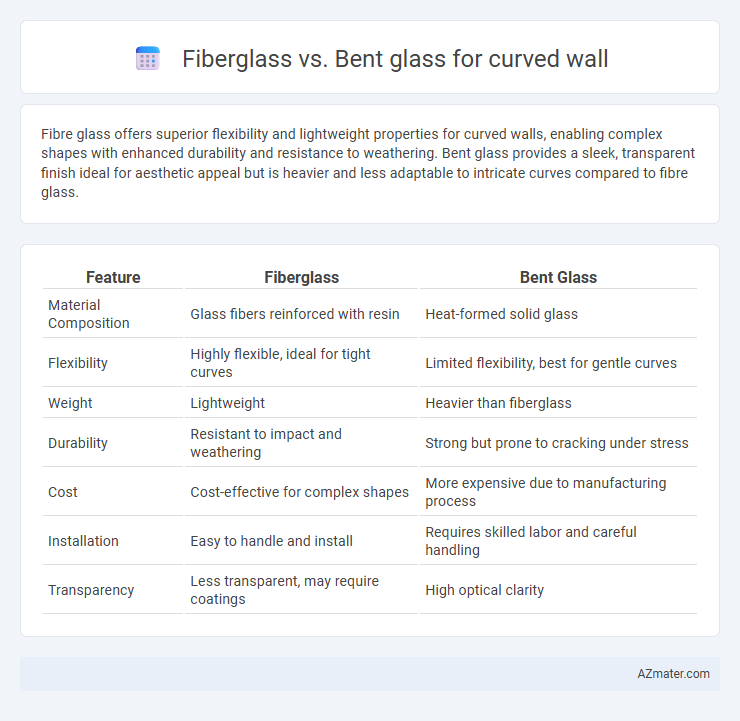Fibre glass offers superior flexibility and lightweight properties for curved walls, enabling complex shapes with enhanced durability and resistance to weathering. Bent glass provides a sleek, transparent finish ideal for aesthetic appeal but is heavier and less adaptable to intricate curves compared to fibre glass.
Table of Comparison
| Feature | Fiberglass | Bent Glass |
|---|---|---|
| Material Composition | Glass fibers reinforced with resin | Heat-formed solid glass |
| Flexibility | Highly flexible, ideal for tight curves | Limited flexibility, best for gentle curves |
| Weight | Lightweight | Heavier than fiberglass |
| Durability | Resistant to impact and weathering | Strong but prone to cracking under stress |
| Cost | Cost-effective for complex shapes | More expensive due to manufacturing process |
| Installation | Easy to handle and install | Requires skilled labor and careful handling |
| Transparency | Less transparent, may require coatings | High optical clarity |
Introduction to Curved Wall Glass Solutions
Curved wall glass solutions utilize either fibre glass or bent glass to achieve sleek, modern architectural designs with seamless curvature. Fibre glass offers lightweight strength and design flexibility, ideal for complex shapes and large spans, while bent glass provides superior clarity and durability with precise curvature formed through heat bending processes. Choosing between fibre glass and bent glass depends on project requirements such as load-bearing capacity, aesthetic quality, and installation complexity for curved wall applications.
What is Fibre Glass?
Fibreglass is a composite material made from fine glass fibers embedded in a resin matrix, offering exceptional strength and flexibility for curved wall applications. It is lightweight, corrosion-resistant, and can be molded into complex shapes, making it ideal for smooth, seamless curved glass wall designs. Compared to bent glass, fibreglass provides enhanced durability and design versatility without the high costs and weight associated with thick, heat-treated curved glass panels.
What is Bent Glass?
Bent glass refers to glass that has been heated and molded into a curved shape to fit architectural designs such as curved walls, offering a smooth and uniform curvature. Unlike fiberglass, which is made from fine glass fibers woven into a composite material, bent glass maintains the clarity and strength of traditional glass but with enhanced flexibility for curved applications. Its seamless form reduces the need for joints, enhancing aesthetics and structural integrity in modern architectural projects.
Manufacturing Processes Compared
Fiberglass curved walls are created using a mold-based layup process, where layers of fiberglass mat or woven roving are saturated with resin and cured to form a strong, lightweight structure that can be easily shaped into complex curves. Bent glass manufacturing involves heating flat glass sheets to a pliable state in a kiln and then bending them over a mold to achieve the desired curvature, followed by controlled annealing to enhance durability and minimize stress. Fiberglass allows more flexibility in shape complexity and faster production, while bent glass offers superior optical clarity and strength but requires precise temperature control and longer processing times.
Strength and Durability Differences
Fibre glass offers exceptional tensile strength and flexibility, allowing it to withstand significant impact and environmental stress without cracking, making it highly durable for curved wall applications. Bent glass, while aesthetically pleasing with its smooth, curved shape, tends to be more brittle and vulnerable to breakage under high stress or impact, limiting its long-term durability compared to fibre glass. The superior strength-to-weight ratio and resistance to corrosion make fibre glass a more reliable choice for structurally demanding curved wall installations.
Aesthetic and Design Flexibility
Fiberglass offers superior design flexibility for curved walls due to its lightweight, moldable nature, allowing for complex shapes and seamless finishes that enhance aesthetic appeal. Bent glass, while providing a sleek, transparent look with a smooth curve, is limited by thickness constraints and manufacturing complexity, often resulting in higher costs and less intricate curvature. Fiberglass's ability to integrate textures and colors directly into the material gives architects broader creative freedom compared to the uniform transparency of bent glass.
Cost Comparison: Fibre vs Bent Glass
Fibre glass offers a cost-effective solution for curved walls, with prices significantly lower than bent glass due to simpler manufacturing processes and reduced material waste. Bent glass involves expensive heating and bending techniques, driving up production costs and often resulting in longer lead times. Choosing fibre glass can reduce overall project expenses while maintaining sufficient durability and flexibility for curved architectural designs.
Performance in Insulation and Safety
Fiberglass curved walls offer superior thermal insulation due to their low thermal conductivity, enhancing energy efficiency and indoor comfort by minimizing heat transfer. Bent glass, while aesthetically appealing with its smooth curves, generally provides lower insulation performance and can pose higher safety risks if shattered, as it lacks the robust impact resistance of fiberglass composites. Fiberglass's inherent strength and flexibility make it a safer choice for curved wall applications, combining effective insulation with enhanced durability and impact resistance.
Installation Challenges and Considerations
Fiberglass offers greater flexibility and lighter weight, simplifying the installation process for curved walls, but requires precise mold shaping and specialized handling to avoid surface imperfections. Bent glass involves complex heating and bending techniques that demand skilled labor and longer lead times, with increased risk of cracking during fabrication and installation. Both materials necessitate careful consideration of support structures, tolerance for curvature, and long-term durability in exterior or interior environments.
Best Applications for Each Glass Type
Fiberglass is ideal for curved walls requiring lightweight, durable, and corrosion-resistant materials, making it perfect for outdoor facades and structures exposed to harsh weather conditions. Bent glass excels in architectural applications demanding aesthetic appeal and structural strength, such as interior curved partitions, balustrades, and advanced curtain walls in commercial buildings. Selecting fiberglass or bent glass depends on priorities like exposure, load-bearing capacity, and design complexity in the curved wall installation.

Infographic: Fibre glass vs Bent glass for Curved wall
 azmater.com
azmater.com